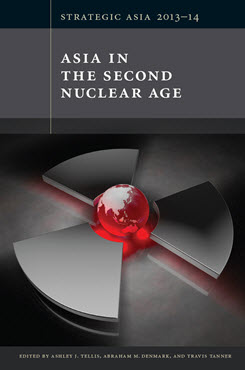Extended Deterrence, Assurance, and Reassurance in the Pacific during the Second Nuclear Age
This chapter assesses Iran’s potential to develop nuclear weapons, the nature of its nuclear decision-making, and the possible consequences and policy implications of Iran’s nuclear choices.
EXECUTIVE SUMMARY
This chapter analyzes the complex relationships that exist around the extended deterrence of China and North Korea, the assurance of U.S. allies in Asia of the reliability of U.S. security guarantees, and the reassurance of China that the U.S. does not seek to thwart its peaceful rise.
MAIN ARGUMENT
The need to simultaneously deter China and North Korea, assure multiple allies, and reassure China, combined with regional nuclear dynamics, makes extended deterrence more complex now than during the Cold War. Particularly challenging is deterring low-level confrontations in the maritime sphere and, in the future, the cyber domain. The Asia-Pacific region is subject to a “security trilemma,” where U.S. actions to deter North Korea can have negative consequences for U.S. and allied security relations with China, making both assurance and reassurance much more difficult. Japan and South Korea have unique assurance requirements and need separate consideration. Reassuring China is particularly important but particularly difficult.
POLICY IMPLICATIONS
- Because both China and U.S. allies (especially Japan) are concerned about extended-deterrence commitments below the nuclear threshold, the U.S. should review the management of those commitments and use the results of that review to expand dialogue with allies and China.
- Because assuring its allies is inherently difficult, the U.S. should continue extensive consultations on extended deterrence, especially with Japan and South Korea, should make no major changes in declaratory policy on nuclear use, and should maintain rough strategic nuclear parity with Russia to avoid allied perceptions of U.S. inferiority.
- Because China believes the U.S. seeks to deny it an effective deterrent, U.S. leaders should reassure China by privately conveying Washington’s acceptance of mutual vulnerability as a fact of life and by working to implement modest confidence-building measures.
Former British defense minister Denis Healey once observed that “it takes only five percent credibility of American retaliation to deter the Russians but ninety-five percent credibility to reassure the Europeans.” [1] He was referring to the Cold War–era difficulty of convincing NATO allies of the credibility of U.S. extended-deterrence commitments, but his words continue to ring true. An abundance of new challenges accompany extended deterrence, assurance, and reassurance in the second nuclear age, as the United States continues to guarantee the sovereignty of more than 30 countries worldwide. Nowhere are these challenges more pronounced than in Northeast Asia, where assuring allies of the United States’ willingness and ability to defend them must be an integral part of U.S. foreign policy. Given that the U.S.-China relationship will be the most important geopolitical dynamic of the next several decades, what are the tasks of and challenges to U.S. extended deterrence in the Pacific?
This chapter begins by defining key terms, including extended deterrence, assurance, and reassurance. It then briefly reviews the requirements of and challenges to extended deterrence during the Cold War before moving on to demonstrate why extended deterrence in the Pacific during the second nuclear age is a unique task. After summarizing current nuclear policy, we identify and analyze five specific challenges to extended deterrence in the Pacific. The chapter then analyzes the implications of these challenges for U.S. nuclear force structure, as well as for nuclear declaratory policy and allied consultation efforts. On the basis of these implications, we offer a number of policy recommendations on how the United States should approach its extended deterrence, assurance, and reassurance efforts in this crucial region over the coming decades.
Extended Deterrence, Assurance, and Reassurance Defined
Extended deterrence, assurance, and reassurance are all strategies of influence that states can direct at adversaries and allies. [2] These three terms are often used interchangeably or given a variety of meanings, so we begin by defining them for the purposes of this analysis. “Extended deterrence” aims to affect the cost calculations of adversaries, specifically dissuading them from attacking a U.S. ally. [3] Extended deterrence is related to, but not synonymous with, assurance. “Assurance” is a strategy directed at allies that seeks to convince them of the United States’ commitment to their defense. [4] “Reassurance,” on the other hand, is a strategy that endeavors to convince adversaries that they are not going to be the target of serious harm. Reassurance may complement extended deterrence, or it may be employed as an entirely distinct strategy. [5] It seeks, in part, to convince an adversary that the military component of extended deterrence is intended to protect the U.S. ally and not to threaten or destabilize the potential aggressor if it refrains from aggression. The target of both extended deterrence and reassurance is an adversary or potential adversary, whereas the target of assurance is an ally…
Endnotes
[1] Denis Healey, Time of My Life (London: Michael Joseph, 1989), 243, quoted in David Yost, “Assurance and U.S. Extended Deterrence in NATO,” International Affairs 85, no. 4 (2009): 768.
[2] Jeffrey W. Knopf, “Varieties of Assurance,” Journal of Strategic Studies 35, no. 3 (2012): 378.
[3] Jeffrey W. Knopf, “Security Assurances: Initial Hypotheses,” in Security Assurances and Nuclear Nonproliferation, ed. Jeffrey W. Knopf (Stanford: Stanford University Press, 2012), 14.
[4] “Exploring the Nuclear Posture Implications of Extended Deterrence and Assurance: Workshop Proceedings and Key Takeaways,” Center for Strategic and International Studies (CSIS), November 2009, 8.
Strategic Asia
The Strategic Asia annual edited volume incorporates assessments of economic, political, and military trends and focuses on the strategies that drive policy in the region. Learn more about Strategic Asia.


